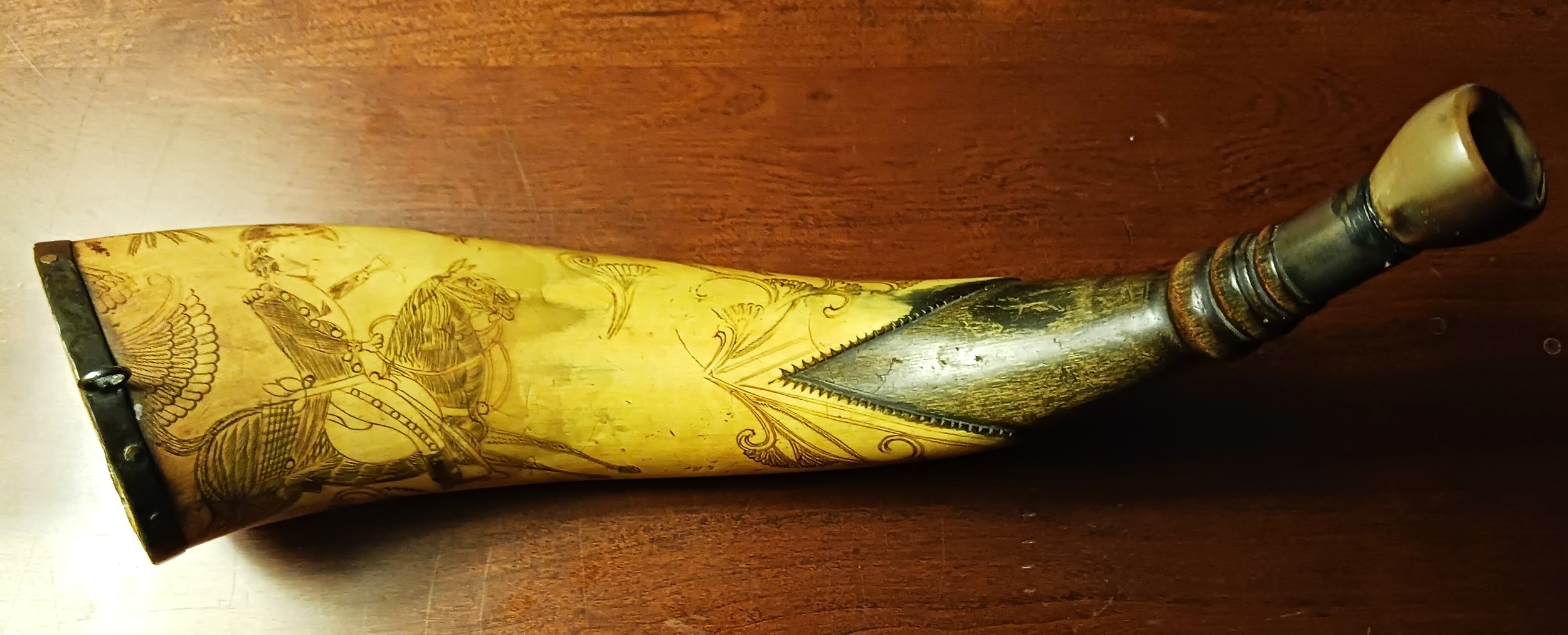A Tansel Powder Horn’s Second Life ©
Foreword: Tansel powder horns, like all frontier horns that were used almost daily, were susceptible to damage if dropped, bumped, or crushed. The most common type of damage came from being dropped on a hard surface. From the author’s experience, about 40% of known Tansel horns have incurred damage on the butt end. Many of those horns have replaced butt plugs and were trimmed on the basal end to remove the damaged/cracked areas… as noted by their reduced basal borders that no longer match the corresponding spout borders. Other dropped horns have retained their original plugs, but only after trimming any damaged areas off the horn and then reducing the diameter of the plug’s base to fit inside the new, slightly smaller opening on the horn. There was always the possibility that the damaged horn would be retired, and some are found that way today. Or, on rare occasions, the damaged horn was repurposed for a different use… such as a blowing horn.
Figure No.1: This circa 1835 Indiana Tansel powder horn was damaged and shortened at its base about 1-1/2 inches as indicated by the cut off wing on the left side of the eagle and missing basal border. A coin silver band reinforces the open end of the horn, and a lathe-turned horn mouthpiece has been mounted in the spout end. Author’s collection, photos by author.
The Damaged Horn: An Indiana family that moved to Missouri carried with them a Tansel powder horn acquired prior to the move. The horn was well carved, made in Indiana about 1835, and several details suggest it was carved by Stark Tansel, a second-generation family carver. At some point the horn was heavily damaged, causing about one and a half inches to be cut off the butt end. The damage and repair were so severe, the “trademark” Tansel eagle lost about half of his right [viewer’s left] wing, in addition to all the carving and basal border beyond that point. The horn could have been salvaged as a shorter powder horn, but the owner opted to convert it into a blowing horn, used to call in dogs back in those days and perhaps wondering children. The conversion was done in a careful manner, proving the horn was still valued by the owner despite its damage. A coin silver band was fitted around the open end and attached with small brass rivets. The spout had a wide silver band, or tube, slid over it with two small brass pins attaching the band to the spout. The same pins also kept a lathe-turned mouthpiece in place. Overall, the conversion was well done and created a fascinating variation among Tansel horns, a Tansel blowing horn. As a study piece, it shows how much the original owner valued the horn, even after being heavily damaged. It was enough to have new silver mountings and a well-made horn mouthpiece added to the horn, so that it would remain a useful and admired object within his household.
Figure No.2: This view shows the silver band around the mouth of the horn and a larger silver band on the spout end where a mouthpiece has been added for blowing the horn. A clean “V” cut and sturdy arrows in the eagle’s claw suggest Stark Tansel may have carved this horn.
Figure No.3: Below the Tansel eagle is a large horse and rider in Military uniform, probably depicting General William H. Harrison. The naturalness of the horse and “soft” knees and elbows on rider support the attribution of Stark Tansel as the probable carver of this horn.
A Partial History: With every horn purchase, the author seeks out any history or background information available on the horn. The Tansel blowing horn was sold by a widow lady in St. Louis, Missouri, who lived in the house her family had occupied for many years and several generations. The blowing horn had been in the family for as long as she could remember. When no longer used, it was hung on the kitchen wall. The lady said it was there when she was a child, and when she finally took it down to sell it, it left the "shape of the horn" on the wall from the paint darkening around it over many years, but not behind the horn where it had protected the wall. She knew the horn was special and “had some value,” but beyond that knew little else. Dimensions [includes the horn mouthpiece]: outside curve 12-1/2," inside curve 10-3/4."
Figure No.4: This view shows the coin silver band around the mouth of the blowing horn with a small silver loop on top for strap/cord attachment. The loss of the horse’s back legs highlights the significant damage done to the horn. Fortunately, the owner still valued the horn and its carving enough to rework it back into a useful object again.
Summary: Powder horns were prone to damage during their working lives if mishandled. If the damage was not excessive, the horn was usually salvaged into a smaller powder horn. But occasionally the owner decided to modify a damaged horn for another use, perhaps to prevent the same type of damage from happening again. In at least one instance, an Indiana Tansel powder horn met that fate, being heavily damaged, but salvaged into a fine blowing horn.




